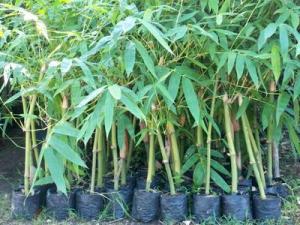Common bamboo or Bambusa vulgaris is a large, tropical, spineless bamboo that can grow up to 20 m tall and up to 10 cm across at the base. It has distinctive triangular culm sheath with hairy edges. Among all other bamboo species, common bamboo is one of the largest and most easily recognize. It has a wide range of uses. The young shoots are edible when cooked. The stems are used as treatment for rheumatism while the shoots are used against abscesses and malaria. The bark is astringent and used to stimulate blood flow in the pelvic area especially during menstruation. The leaves are used as treatment for heart problems and malaria as well. It is also boiled and used in bath to ease fever. Common bamboo is used in erosion control on sloping ground. The stems are used for light construction, handicrafts, and are a good source of fibre for papermaking.Common bamboo is a plant of the moist, lowland tropics. It grows best in areas where annual daytime temperatures are within the range 22 – 28c, but can tolerate 9 – 32c[ 418 ]. The stems die back to the ground if exposed to frost, but if the frost was not too severe the plant may resprout from the rhizomes[ 418 ]. It prefers a mean annual rainfall in the range 1,200 – 2,500mm, but tolerates 700 – 4,500mm[ 418 ]. Requires a moist, fertile, humus rich soil in full sun or dappled shade in warm humid conditions[ 200 , 302 ]. Prefers a pH in the range 5 – 6, tolerating 4.5 – 6.5[ 418 ]. Widely grown throughout the tropics for its many uses and as an ornamental, the plant sometimes escapes from cultivation and becomes naturalized. It forms extensive monospecific stands, excluding other plant species[ 413 ]. It is classified as ‘Invasive’ in some Pacific Islands[ 299 , 305 ]. Harvesting normally starts 3 years after planting with full production being reached after 6 – 8 years. Selective cutting of stems 2-year-old or older is recommended. In tropical Africa it has been recommended to selectively harvest one half to two-thirds of the adult stems on a clump every 3 – 4 years. Young shoots for consumption should be harvested in the first week of their emergence[ 299 ]. Annual yields of up to 20 tonnes (dry weight) of the canes per hectare have been achieved[ 299 ].


